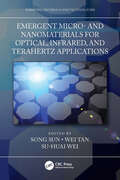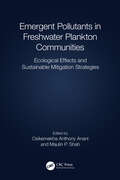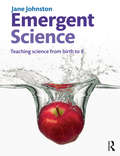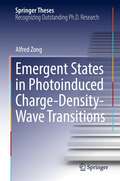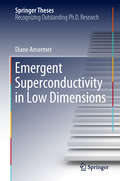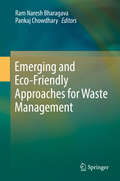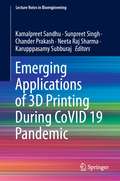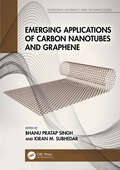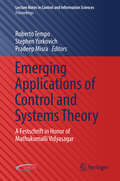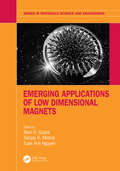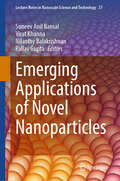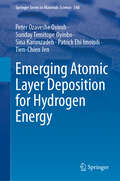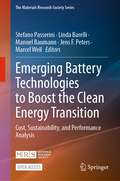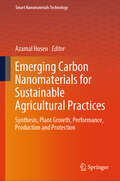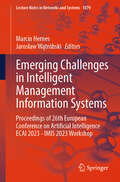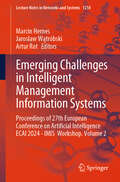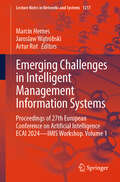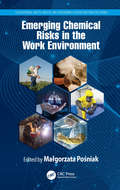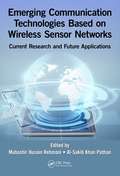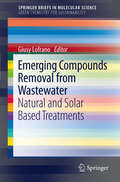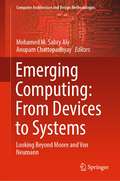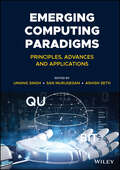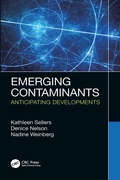- Table View
- List View
Emergent Micro- and Nanomaterials for Optical, Infrared, and Terahertz Applications (Emerging Materials and Technologies)
by Song Sun Wei Tan Su-Huai WeiDriven by continuing pursuits in device miniaturization and performance improvement, emergent micro- and nanomaterials hold the keys to enabling next-generation technologies in optical, infrared, and terahertz applications, owing to their unique properties and strong responses in these frequency bands. Development of these fascinating materials has triggered a number of opportunities in the applied sciences, and some have even made their impact in the market. Emergent Micro- and Nanomaterials for Optical, Infrared, and Terahertz Applications reviews state-of-the-art developments in various emergent materials and their implementation in applications such as sensors, waveplates, communications, and light sources, among others. The book discusses the similarities, advantages, and limitations and offers a comparative of each material. This volume: Covers all emergent materials (natural and artificial) that are promising for optical, infrared, and terahertz applications Comparatively analyzes these materials, elucidating their unique advantages, limitations, and application scopes Provides an up-to-date record on achievements and progress in cutting-edge optical, infrared, and terahertz applications Offers a comprehensive overview to connect multidisciplinary fields, such as materials, physics, and optics, to serve as a basis for future progress This book is a valuable reference for engineers, researchers, and students in the areas of materials and optics, as well as physics, and will benefit both junior- and senior-level researchers.
Emergent Pollutants in Freshwater Plankton Communities: Ecological Effects and Sustainable Mitigation Strategies
by Osikemekha Anthony Anani Maulin P. ShahEmergent Pollutants in Freshwater Plankton Communities introduces the environmental and health monitoring techniques for emergent pollutants and their influences on the community structure of lentic freshwater plankton. It highlights the challenges posed by the improper treatment or disposal of industrial pharmaceutical wastes, which could cause numerous related environmental and health risks. It also suggests possible sustainable mitigation techniques for the treatment of emerging pollutants. Further, it addresses the issues of regulatory and monitoring frameworks, and reviews laws governing the management and disposal of wastes. This book will help students, researchers, and professionals address the underlying issues of waste water pollutants from various industries and ideally provide methods to achieve a sustainable and pollutant-free environment for the present and future generations. Presents detailed information regarding emergent pollutant effects on freshwater organisms, as well as mitigation and remediation techniques. Discusses foundational information regarding issues of wastes water pollutants from pharmaceuticals, personal care products/cosmetics, and other various industries. Examines several sustainable mitigation techniques for the treatment of waste pollutants. Addresses the issues of regulatory and monitoring frameworks and reviews laws governing the disposal and management of waste.
Emergent Science: Teaching science from birth to 8
by Jane JohnstonEmergent Science is essential reading for anyone involved in supporting scientific learning and development with young children aged between birth and 8. Drawing on theory, the book helps to develop the essential skills needed to understand and support science in this age range. The book is organised into three parts: development, contexts and pedagogy, exploring the underpinning theory alongside practical ideas to help trainees, teachers and childcare practitioners to create high-quality science experiences for the children they teach. The text includes guidance on developing professional, study and research skills to graduate and postgraduate level, as well as all the information needed to develop scientific skills, attitudes, understanding and language through concrete, social experiences for young children. Features include: Reflective tasks-at three levels of professional development;- early career/student, developing career/teacher and later career/leader. Case studies that exemplify good practice and practical ideas. Tools for learning - explain how science professionals can develop their professional, study skills and research skills to Masters level
Emergent States in Photoinduced Charge-Density-Wave Transitions (Springer Theses)
by Alfred ZongThis book advances understanding of light-induced phase transitions and nonequilibrium orders that occur in a broken-symmetry system. Upon excitation with an intense laser pulse, materials can undergo a nonthermal transition through pathways different from those in equilibrium. The mechanism underlying these photoinduced phase transitions has long been researched, but many details in this ultrafast, non-adiabatic regime still remain to be clarified. The work in this book reveals new insights into this phenomena via investigation of photoinduced melting and recovery of charge density waves (CDWs). Using several time-resolved diffraction and spectroscopic techniques, the author shows that the light-induced melting of a CDW is characterized by dynamical slowing-down, while the restoration of the symmetry-breaking order features two distinct timescales: A fast recovery of the CDW amplitude is followed by a slower re-establishment of phase coherence, the latter of which is dictated by the presence of topological defects in the CDW. Furthermore, after the suppression of the original CDW by photoexcitation, a different, competing CDW transiently emerges, illustrating how a hidden order in equilibrium can be unleashed by a laser pulse. These insights into CDW systems may be carried over to other broken-symmetry states, such as superconductivity and magnetic ordering, bringing us one step closer towards manipulating phases of matter using a laser pulse.
Emergent Superconductivity in Low Dimensions (Springer Theses)
by Diane AnsermetThis book explores the relationship between electronic correlations, dimensionality, inhomogeneities, and superconductivity in low-dimensional systems by studying single crystals of the quasi-one-dimensional Na2–δMo6Se6, composed of MoSe filaments weakly coupled by Na atoms and subject to intrinsic disorder (δ > 0). It shows that the Na2-δMo6Se6 displays strong electronic correlations in its normal state, whereas a superconducting ground state emerges from Anderson localized electrons. Two novel behaviors of the superconducting state are observed: first, a disorder induced enhancement of the superconducting transition temperature; second, a reentrant phase coherence with increasing temperature, magnetic field, and current. It also analyzes the intrinsic properties of Na2-δMo6Se6 are analyzed to offer a thorough understanding of these phenomena. The emergence of superconductivity in such low-dimensional systems provides a fruitful playground to explore electronic order and correlations.
Emerging and Eco-Friendly Approaches for Waste Management
by Pankaj Chowdhary Ram Naresh BharagavaRapid industrialization is a serious concern in the context of a healthy environment. With the growth in the number of industries, the waste generated is also growing exponentially. The various chemical processes operating in the manufacturing industry generate a large number of by-products, which are largely harmful and toxic pollutants and are generally discharged into the natural water bodies. Once the pollutants enter the environment, they are taken up by different life forms, and because of bio-magnification, they affect the entire food chain and have severe adverse effects on all life forms, including on human health. Although, various physico-chemical and biological approaches are available for the removal of toxic pollutants, unfortunately these are often ineffective and traditional clean up practices are inefficient. Biological approaches utilizing microorganisms (bacterial/fungi/algae), green plants or their enzymes to degrade or detoxify environmental pollutants such as endocrine disruptors, toxic metals, pesticides, dyes, petroleum hydrocarbons and phenolic compounds, offer eco- friendly approaches. Such eco-friendly approaches are often more effective than traditional practices, and are safe for both industry workers as well as environment. This book provides a comprehensive overview of various toxic environmental pollutants from a variety natural and anthropogenic sources, their toxicological effects on the environment, humans, animals and plants as well as their biodegradation and bioremediation using emerging and eco-friendly approaches (e.g. Anammox technology, advanced oxidation processes, membrane bioreactors, membrane processes, GMOs), microbial degradation (e.g. bacteria, fungi, algae), phytoremediation, biotechnology and nanobiotechnology. Offering fundamental and advanced information on environmental problems, challenges and bioremediation approaches used for the remediation of contaminated sites, it is a valuable resource for students, scientists and researchers engaged in microbiology, biotechnology and environmental sciences.
Emerging and Priority Pollutants in Rivers
by Helena Guasch Antoni Ginebreda Anita GeiszingerThe enduring changes in the aquatic environment and the increasing influx of contaminants call for novel conceptual and methodological approaches to relating chemical pollution and ecological alterations in ecosystems. This volume highlights the latest advances concerning the sampling, analyses, occurrence, bioavailability, and effects of emerging and priority pollutants in European rivers, the current status of the River Management Plans in Europe, and the applicability of the newly developed techniques for water monitoring purposes. The topics are discussed in the context of the EU Water Framework Directive, evaluating their shortcomings and providing a basis for doing away with them. Linking scientific research and river management practices, this book is an invaluable source of information for environmental chemists, aquatic scientists, ecologists and water managers.
Emerging Applications of 3D Printing During CoVID 19 Pandemic (Lecture Notes in Bioengineering)
by Kamalpreet Sandhu Sunpreet Singh Chander Prakash Neeta Raj Sharma Karupppasamy SubburajThis book presents various practical breakthroughs of 3D printing (3DP) technologies in developing different types of tool and gadgets to be used against COVID-19 pandemic. It presents multidisciplinary aspects of 3DP technology in social, medical, administration, and scientific areas. This book presents state-of-the-art applications of 3DP technology in the development of PPE, ventilators, respiratory equipments, and customized drugs. It provides a comprehensive collection of the technical notes, research designs, literature prospective, and clinical applications of 3DP technologies to effectively deal with the COVID-19 pandemic. This book will be beneficial for the medical professionals, pharmacists, manufacturing enterprises, and young scholars in understanding the real potential of 3DP technologies in aiding humans-based activities against the COVID-19 crisis. Having interdisciplinary applications in applied science, this book will also be useful for wide range of academicians, research scholars and industry stakeholders.
Emerging Applications of Carbon Nanotubes and Graphene (Emerging Materials and Technologies)
by Bhanu Pratap Singh Kiran M SubhedarThis book comprehensively reviews recent and emerging applications of carbon nanotubes and graphene materials in a wide range of sectors. Detailed applications include structural materials, ballistic materials, energy storage and conversion, batteries, supercapacitors, smart sensors, environmental protection, nanoelectronics, optoelectronic and photovoltaics, thermoelectric, and conducting wires. It further covers human and structural health monitoring, and thermal management applications. Key selling features: Exclusively takes an application-oriented approach to cover emerging areas in carbon nanotubes and graphene Covers fundamental and applied knowledge related to carbon nanomaterials Includes advanced applications like human and structural health monitoring, smart sensors, ballistic protection and so forth Discusses novel applications such as thermoelectrics along with environmental protection related application Explores aspects of energy storage, generation and conversion including batteries, supercapacitors, and photovoltaics This book is aimed at graduate students and researchers in electrical, nanomaterials, chemistry, and other related areas.
Emerging Applications of Control and Systems Theory: A Festschrift In Honor Of Mathukumalli Vidyasagar (Lecture Notes In Control And Information Sciences - Proceedings Ser.)
by Roberto Tempo Stephen Yurkovich Pradeep MisraThis book celebrates Professor Mathukumalli Vidyasagar’s outstanding achievements in systems, control, robotics, statistical learning, computational biology, and allied areas. The contributions in the book summarize the content of invited lectures given at the workshop “Emerging Applications of Control and Systems Theory” (EACST17) held at the University of Texas at Dallas in late September 2017 in honor of Professor Vidyasagar’s seventieth birthday. These contributions are the work of twenty-eight distinguished speakers from eight countries and are related to Professor Vidyasagar’s areas of research. This Festschrift volume will remain as a permanent scientific record of this event.
Emerging Applications of Low Dimensional Magnets (Series in Materials Science and Engineering)
by Ram K. Gupta Sanjay Mishra Tuan Anh NguyenLow-dimensional magnetic materials find their wide applications in many areas, including spintronics, memory devices, catalysis, biomedical, sensors, electromagnetic shielding, aerospace, and energy. This book provides a comprehensive discussion on magnetic nanomaterials for emerging applications. Fundamentals along with applications of low-dimensional magnetic materials in spintronics, catalysis, memory, biomedicals, toxic waste removal, aerospace, telecommunications, batteries, supercapacitors, flexible electronics, and many more are covered in detail to provide a full spectrum of their advanced applications. This book offers fresh aspects of nanomagnetic materials and innovative directions to scientists, researchers, and students. It will be of particular interest to materials scientists, engineers, physicists, chemists, and researchers in electronic and spintronic industries, and is suitable as a textbook for undergraduate and graduate studies.
Emerging Applications of Novel Nanoparticles (Lecture Notes in Nanoscale Science and Technology #37)
by Suneev Anil Bansal Virat Khanna Nilanthy Balakrishnan Pallav GuptaThis book is a comprehensive and modern guide on emerging nanoparticles and their diverse applications in engineering, medicine, food safety, transportation, energy, agriculture, and environmental sustainability. Written by leading researchers from all over the world, it is designed to cover the full range of nanoparticles as well as provide in-depth detail regarding their development, characterization, processing, and synthesis. The book is divided into two sections: the first covers the development of advanced nanoparticles and the second is dedicated to their variety of cutting-edge applications. The authors also cover the unique properties and green synthesis of nanoparticles as well as their use as nanobiosensors, nanopesticide, nanofertilizer, and as energy storage and conversion devices, just to name a few. This book provides readers with insight onto the broad scope of computational, theoretical, and experimental research on novel nanoparticles and their applications. It is ideal for both young and experienced researchers and industry professionals in the field of nanotechnology.
Emerging Atomic Layer Deposition for Hydrogen Energy (Springer Series in Materials Science #348)
by Peter Ozaveshe Oviroh Sunday Temitope Oyinbo Sina Karimzadeh Patrick Ehi Imoisili Tien-Chien JenThis book focuses on Atomic Layer Deposition (ALD) and its applications in the field of green hydrogen energy. It covers the fundamental understanding of how new functional materials can be synthesized by ALD, and provides insights into its use in advanced nanopatterning for microelectronics, energy storage systems, desalination, catalysis, and medical fields. The book also highlights the advancements in computational and experimental methodologies for optimizing ALD processes in the context of green hydrogen energy. The book addresses aspects that might affect deposition and green hydrogen energy, and presents analysis and characterization techniques in the field. With specific examples illustrating the progress in green hydrogen ALD processes and their impact on other technologies, this book aims to enable the reduction of cost, energy waste, and adverse environmental impacts associated with hydrogen energy. It provides a comprehensive overview of ALD technology, hydrogen production, purification, and storage methods, modeling and simulation techniques, analysis and characterization approaches, and future perspectives on green hydrogen energy.
Emerging Battery Technologies to Boost the Clean Energy Transition: Cost, Sustainability, and Performance Analysis (The Materials Research Society Series)
by Stefano Passerini Linda Barelli Manuel Baumann Jens F. Peters Marcel WeilThis open access book provides a totally new perspective on the rapidly developing sector of electrochemical energy storage, putting a spotlight on their sustainability under consideration of the latest developments and emerging future technologies. A number of selected, high-level authors from different disciplines discuss the potential contribution of batteries to a cleaner society, the need for new battery concepts, necessary new chemistries and their sustainability. These include not only analyses of the most relevant technological developments in the field, but also the latest state of knowledge in terms of their applicative functionalities in transport and stationary applications within the clean energy transition framework, their potential environmental impacts, resource demands and social impacts, and the corresponding methodological advances. All these aspects are analyzed on micro-level (i.e., for the specific technology), but also on macro-scale i.e., from a systemic perspective, providing a glimpse on how emerging battery systems might cover future energy storage demand. By taking a prospective and interdisciplinary viewpoint, this book will be of interest for a broad field of readers interested in electrochemistry, engineering with particular focus on electric grids and on-board systems and energy system analysis, but also those worried about the sustainability and societal challenges related with the energy transition(s).
Emerging Carbon Nanomaterials for Sustainable Agricultural Practices: Synthesis, Plant Growth, Performance, Production and Protection (Smart Nanomaterials Technology)
by Azamal HusenThe potential use of carbon-based nanomaterials in overall plant systems has not yet received much research, and the results that have been reported are typically descriptive and inconsistent with little knowledge of the underlying mechanisms of action. Changes in gene expression and enhanced ROS production are among the physiological processes that may be impacted by interactions with carbon nanomaterials. They penetrate plant cells, are readily taken up by plants, and then influence the key events of plants such as seed germination, seedling growth, root formation, photosynthesis, flowering, yield, and overall performance. Moreover, in terms of soil quality, carbon nanomaterials have the capacity to influence the health status of agricultural soils, and thus, increase sustainable agriculture practices. Currently, plant disease management depends mainly on toxic pesticides that are potentially harmful to humans and the environment. These particles have enabled their use as bactericides, fungicides, and nanofertilizers. Carbon nanomaterials, however, which may be helpful in plant nucleic acid delivery, pesticide and fertilizer application, wastewater treatment, eradication of pathogen-induced plant illnesses, and detection of significant plant molecules, are the subject of this book. The use of carbon nanoparticles in tissue culture medium and plant growth performance has also been examined. The so-called ‘safe-by-design’ strategy for a guided design of nanomaterials without harmful environmental side effects requires knowledge of the special structural properties of particles that determine the deleterious impacts on living beings. Accordingly, the environmental safety, and ethical issues related to the use of carbon nanomaterials in agricultural sectors have been also explored. Overall, the book in hand provides an extensive, important, and selected topic related to carbon nanomaterials in agricultural sectors. This book provides valuable information to scientists, researchers, and students, working especially on agricultural science, plant science, plant pathology, plant biology, plant nanobiotechnology, plant biochemistry, soil microbiology, and other allied subjects.
Emerging Challenges in Intelligent Management Information Systems: Proceedings of 26th European Conference on Artificial Intelligence ECAI 2023 - IMIS 2023 Workshop (Lecture Notes in Networks and Systems #1079)
by Marcin Hernes Jarosław WątróbskiThis book contains the proceedings of the ECAI 2023 Workshop on Intelligent Management Information Systems (IMIS 2023). IMIS 2023 was part of the 26th European Conference on Artificial Intelligence ECAI 2023, held in Krakow from September 30, 2023, to October 4, 2023. The book discusses emerging challenges related to implementing artificial intelligence in Management Information Systems. The main focus is put on machine learning, including deep learning to support business processes, artificial intelligence for financial systems and cryptocurrencies, intelligent human–computer interfaces, knowledge management in business organizations, hybrid artificial intelligence, and multiple criteria decision analysis methods. The book is divided into four major parts covering the main issues related to the topic. The first part presents issues related to application of artificial intelligence in information systems. The second part is devoted to advanced machine learning methods to support business processes. The third part presents problems related to the social aspects of artificial intelligence in management. The fourth part is devoted to intelligent multiple criteria decision analysis methods. The book holds an interdisciplinary character; therefore, it is intended for a broad scope of readers, including researchers, students, managers, and employees of business organizations, software developers, IT, and management specialists.
Emerging Challenges in Intelligent Management Information Systems: Proceedings of 27th European Conference on Artificial Intelligence ECAI 2024 - IMIS Workshop. Volume 2 (Lecture Notes in Networks and Systems #1218)
by Marcin Hernes Jaroslaw Wątróbski Artur RotThis book contains the second volume of proceedings of the ECAI 2024 Workshop on Intelligent Management Information Systems (IMIS 2024). IMIS 2024 was part of the 27th European Conference on Artificial Intelligence ECAI 2024, held in Santiago de Compostela from October 19, 2024, to October 24, 2024. The book discusses emerging challenges related to implementing artificial intelligence in management information systems. The main focus is put on knowledge management and machine learning methods in information systems, artificial intelligence for decision support systems, intelligent customer management methods, hybrid artificial intelligence, and multiple criteria decision analysis methods and advanced computational methods for support business processes and decision-making. The book is divided into three major parts covering the main issues related to the topic. The first part presents issues related to the knowledge management in intelligent information systems. The second part is devoted to application of machine learning in management information systems. The third part presents problems related to multiple criteria decision analysis and computational methods. The book has an interdisciplinary character; therefore, it is intended for a broad scope of readers, including researchers, students, managers, and employees of business organizations, software developers, IT, and management specialists.
Emerging Challenges in Intelligent Management Information Systems: Proceedings of 27th European Conference on Artificial Intelligence ECAI 2024 - IMIS Workshop. Volume 1 (Lecture Notes in Networks and Systems #1217)
by Marcin Hernes Jaroslaw Wątróbski Artur RotThis book contains the first volume of proceedings of the ECAI 2024 Workshop on Intelligent Management Information Systems (IMIS 2024). IMIS 2024 was part of the 27th European Conference on Artificial Intelligence ECAI 2024, held in Santiago de Compostela from October 19, 2024, to October 24, 2024. The book discusses emerging challenges related to implementing artificial intelligence in management information systems. The main focus is put on machine learning, including deep learning to support business processes, artificial intelligence for financial systems and cryptocurrencies, hybrid artificial intelligence, and multiple criteria decision analysis methods. The book is divided into three major parts covering the main issues related to the topic. The first part presents issues related to application of artificial intelligence in information systems. The second part is devoted to advanced machine learning and data processing methods to support business processes. The third part is devoted to intelligent multiple-criteria decision analysis methods. The book has an interdisciplinary character; therefore, it is intended for a broad scope of readers, including researchers, students, managers, and employees of business organizations, software developers, IT, and management specialists.
Emerging Challenges to Food Production and Security in Asia, Middle East, and Africa: Climate Risks and Resource Scarcity
by Mohamed Behnassi Mirza Barjees Baig Mahjoub El Haiba Michael R. ReedThis book, as a part of a series of CERES publications, provides a multi-regional and cross-sectoral analysis of food and water security, especially in the era of climate risks, biodiversity loss, pressure on scarce resources, especially land and water, increasing global population, and changing dietary preferences. It includes both conceptual research and empirically-based studies, which provides context-specific analyses and recommendations based on a variety of case studies from Africa, Middle East, and Asia regarding the fostering of long-term resilience of food and water security. The core approach of the volume consists of: assessing the structural drivers affecting the vulnerability of food and water security, under the persistence of current trends; identifying the best solutions and practices to enhance the climate resilience for food and water security; and fostering climate adaptation and biodiversity protection for food and water security.
Emerging Chemical Risks in the Work Environment (Occupational Safety, Health, and Ergonomics)
by Małgorzata PośniakAround the world, the production and use of nanomaterials, as well as carcinogenic, mutagenic, reprotoxic substances (CMR) and endocrine disruptors has systematically increased. The increase in production has exposed workers to hazardous substances in practically all branches of the world economy. Readers will have access to up-to-date and comprehensive knowledge on emerging risks related to nanomaterials, endocrine disruptors, reprotoxic, carcinogenic and mutagenic substances, which are related to the development of technologies and workplaces. The book will provide the tools for occupational risk assessment of chemical substances for which there are no safety levels of exposure as well as an indication of methods and measurements to protect human health and reduce chemical risks at the workplace. This book creates awareness for employers, employees and safety experts about emerging risks related to chemical agents resulting in the reduction of cancer, reproductive system diseases, cases of abnormal child development, hormonal system disorders leading to abnormal metabolism, obesity, and diabetes. Features: Comprehensive information on emerging and newly identified chemical hazards Delivers the latest data on methods and tools for identification, assessing and reducing health risks Provides practical occupational safety advice and recommendations Real life examples from measurements carried out in the workplaces "The monograph, due to the high universality of its considerations, can be addressed to a very wide audience. It is an important compendium of knowledge, which can be used by health and safety services, employers, people designing new technologies and those interested in this issue. It is a valuable and up-to-date study, among others because it uses the latest literature and quotes current legal acts.” —Sławomir Czerczak, Nofer Institute of Occupational Medicine, Poland
Emerging Communication Technologies Based on Wireless Sensor Networks: Current Research and Future Applications
by Al-Sakib Khan Pathan Mubashir Husain RehmaniThis book fills a gap in the existing literature by combining a plethora of WSN-based emerging technologies into a single source so that reviewers can form opinions regarding these technologies. It presents different types of emerging communication technologies based on WSNs and describes how wireless sensor networks can be integrated with other communication technologies. It covers many of the new techniques and demonstrates the application of WSNs. The book is composed of 14 chapters, divided into four parts.
Emerging Compounds Removal from Wastewater
by Giusy LofranoIn the last years the release of emerging pollutants such as Endocrine Disruptors (EDCs), Pharmaceuticals and Personal Care Products (PPCPs) into the environment has raised great concern. While investigating how to treat emerging pollutants from water and wastewater, researchers have drawn attention on the implementation of more environmentally friendly technologies able to achieve high removal efficiency at low costs. Emerging Compounds Removal from Wastewater by Green Technologies: Natural and Solar Based Treatments introduces green chemistry in relation to these treatment technologies. More specifically, this volume: * Reviews the suitability of alternative adsorption processes that use natural adsorbents natural materials or agricultural waste in light of the inefficiency of conventional wastewater treatment plants; * Evaluates the potential of constructed wetlands for the removal of some categories of trace contaminant of worldwide relevance in view of their application as decentralized systems; * Highlights the promising role of a special class of oxidation techniques defined as Advanced Oxidation Processes (AOPs) supported by sunlight. This volume will be of great interest to students, technicians, and academics alike who are interested in evaluating and selecting the technologies that lead to better and more sustainable treatment of this huge class of pollutants.
Emerging Computing: Looking Beyond Moore and Von Neumann (Computer Architecture and Design Methodologies)
by Mohamed M. Sabry Aly Anupam ChattopadhyayThe book covers a range of topics dealing with emerging computing technologies which are being developed in response to challenges faced due to scaling CMOS technologies. It provides a sneak peek into the capabilities unleashed by these technologies across the complete system stack, with contributions by experts discussing device technology, circuit, architecture and design automation flows. Presenting a gradual progression of the individual sub-domains and the open research and adoption challenges, this book will be of interest to industry and academic researchers, technocrats and policymakers.Chapters "Innovative Memory Architectures Using Functionality Enhanced Devices" and "Intelligent Edge Biomedical Sensors in the Internet of Things (IoT) Era" are available open access under a Creative Commons Attribution 4.0 International License via link.springer.com.
Emerging Computing Paradigms: Principles, Advances and Applications
by Umang Singh San Murugesan Ashish SethEMERGING COMPUTING PARADIGMS A holistic overview of major new computing paradigms of the 21st Century In Emerging Computing Paradigms: Principles, Advances and Applications, international scholars offer a compendium of essential knowledge on new promising computing paradigms. The book examines the characteristics and features of emerging computing technologies and provides insight into recent technological developments and their potential real-world applications that promise to shape the future. This book is a useful resource for all those who wish to quickly grasp new concepts of, and insights on, emerging computer paradigms and pursue further research or innovate new novel applications harnessing these concepts. Key Features Presents a comprehensive coverage of new technologies that have the potential to shape the future of our world—quantum computing, computational intelligence, advanced wireless networks and blockchain technology Revisits mainstream ideas now being widely adopted, such as cloud computing, the Internet of Things (IoT) and cybersecurity Offers recommendations and practical insights to assist the readers in the application of these technologies Aimed at IT professionals, educators, researchers, and students, Emerging Computing Paradigms: Principles, Advances and Applications is a comprehensive resource to get ahead of the curve in examining and exploiting emerging new concepts and technologies. Business executives will also find the book valuable and gain an advantage over competitors in harnessing the concepts examined therein.
Emerging Contaminants: Anticipating Developments
by Kathleen Sellers Denice K. Nelson Nadine WeinbergEmerging Contaminants: Anticipating Developments examines the factors that have led "new" environmental contaminants to emerge in the past and combines the lessons learned to anticipate potential new developments. The analyses described in this book originate in multiple disciplines: the science of toxicology; environmental law and regulation; the field of product stewardship; and the social science which explains why ideas take hold. Over a dozen case studies of contaminants that emerged as environmental issues over the last hundred years illustrate crucial points. The results of the analyses in this book support a step-by-step method to assess the potential for a contaminant to emerge, and a framework to apply those conclusions to managing site liabilities. Features: Describes an unprecedented understanding of why contaminants emerge as issues, based on a multidisciplinary analysis Makes abstract concepts tangible, basing analyses on data and illustrating key points with case studies Enables readers to anticipate and prepare to manage future challenges associated with emerging chemicals Presents an analytical framework for companies to assess and manage business risks Written for regulators, policymakers, industry professionals with responsibility for contaminated site management, as well as attorneys, and consultants, this book provides a framework for anticipating the emergence of new contaminants so that the risks–whether to human health and the environment or to a business–can be anticipated and appropriately managed.
